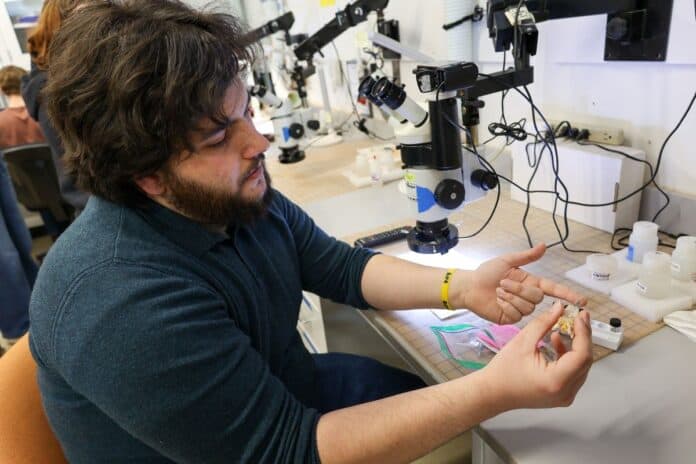The best jaw for hunting fast fish is long and full of sharp teeth.
This makes sense to us, but it also makes sense in nature: New fossil evidence from Virginia Tech geoscientists revealed that different species of predatory fish independently evolved similar jaw structure hundreds of millions of years apart.
“The same evolutionary problem is being solved in the same way. You make yourself into an arrow, and you turn your jaws into a fish trap,” said Jack Stack, a graduate student in the Department of Geosciences and lead author on an April study published the Journal of Vertebrate Paleontology.
Working alongside paleobiologists Michelle Stocker and Sterling Nesbitt with junior microbiology major Maranda Stricklin, Stack drew this conclusion by analyzing a fossilized Triassic-era fish, Saurichthys justicias (pronounced sir-ick-these), sifted out of an ancient river deposit in western Texas.
This particular deposit has been a treasure trove for the Virginia Tech fossil team. But it probably was “pretty gross” when the river was flowing 225 million years ago, Stack said.
“It was a muddy little pool, full of poop and dead animals, dead fish,” Stack said.
The paleobiologists recognized a fossiliferous rock layer when they spotted fossil fish scales, a telltale sign that more fossils could be found beneath the surface.
After collecting and screenwashing sediment from the site, they sorted it under a microscope and took high-resolution photos. When the jawbone emerged, Stricklin took point. The undergraduate researcher used micro-CT scanning technology to create a three-dimensional cross section, revealing all that remained of a foot-long skillful killer.
The wicked countenance resembles modern-day pike or needlefish with their elongated toothy jaws, and yet Saurichthys justicias evolved entirely independently from these fish. It is from an extinct branch of ray-finned fishes — a group that comprises more than 50 percent of all living vertebrate species, including familiar animals such as goldfish, tuna, bass, and approximately 35,000 other species.
In addition to uncovering how and why certain evolutionary traits reemerge again and again, long-lost Saurichthys justicias is already helping scientists reconstruct the history of ray-finned fish to better understand today’s animals and better anticipate how they will respond to freshwater ecosystem changes still to come.

New genus and species
- The genus name Saurichthys derives from the Greek word “sauros” meaning lizard and the Greek word “Ichthus” meaning fish.
- The species name justicias derives from the Latin term “iustitia” meaning justice, named for the town of Justiceburg, Texas, where the fossil was unearthed.
By Kelly Izlar

